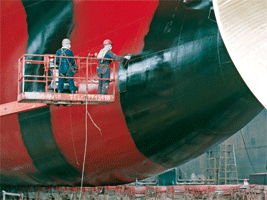You may have noticed more crews conducting road repairs during the seasonal spring thaw. Relatedly, it may seem that you find another severe pothole almost every time you take a trip in the car, regardless of the route. Here’s a closer look at how spring thaws affect asphalt.
The Freeze-Thaw Cycle Exacerbates Issues
The freeze-thaw cycle refers to when temperatures fluctuate just above or below freezing. These changes can affect water in pipes and the asphalt in certain regions. That’s particularly true when a location is coming out of a period of heavy snowfall as temperatures warm up for spring.
The main issue is that water takes up approximately 10% more space when it freezes to a solid from a liquid. Consider a case where fluid from thawing snow seeps down into an asphalt crack. It pushes that opening out further as it freezes, making it worse.
The problem can become more severe if the water reaches the subpavement level, reaching the surrounding gravel and soil. Then, it becomes a bubble of frozen water that starts putting pressure on the asphalt above. When a heavy vehicle drives over the affected area, the asphalt caves in, creating a pothole.
Climate Change Could Increase the Need for Road Repairs
Scientists warn that climate change will have many damaging effects, including some people probably don’t expect. One of them could negatively impact road conditions. One study of New Hampshire roads tried to quantify the potential impact. It found that average temperatures climbing 4.5 degrees Fahrenheit higher than in the 1980s and 1990s would affect the freeze-thaw cycle.
New Hampshire would not have its traditional winter but a longer autumn instead. The researchers’ concern was that the freeze-thaw fluctuations would happen even more frequently if there were not enough consecutive days cold enough to keep temperatures below freezing. If that happens, it would wreak havoc on the roads in winter, plus make them more likely to develop ruts in the summer.
As of February 2022, public works representatives in New Hampshire were already feeling the pressure. Joe Lynch, the deputy director of Hampton Public Works, said, “A typical winter, we’ll put a crew out a few days a week, just to stay ahead of them. This particular week, we’ve had three to four crews out on a full-time basis all day long.”
It was a similar story in Maine. "We are seeing more fluctuation in temperature above and below freezing — it just keeps bouncing around," said Brian Burne, highway maintenance engineer at the Maine Department of Transportation. "I can absolutely say those types of fluctuations in temperature, added with rain that saturates the soil and freezes it again, is more damaging to the road.”
Public works crews do ongoing maintenance to keep roads safe for everyone involved. One study showed that applying high-friction surface treatments to horizontal curves reduced road accident frequency. The average rate fell from 6.2 to 1.9 incidents annually. Such treatments improve traction on wet and dry pavement. However, when pothole reduction is the goal, a common technique is to use crack fillers. Those substances mitigate the problems freeze-thaw cycles can cause.
Local Road Restrictions May Result in Transit Disruptions
In one U.S. city, filling the 1,500 potholes identified in a year required 78 tons of hot asphalt. However, such repairs are often costly. An update from the Road and Bridge Department in Bonner County, Idaho, mentioned a 20% rise in asphalt costs.
Officials understandably want to prevent such road issues as possible. Brands including Walmart use route-planning technology when distributing shipped items. However, people from any company using heavy vehicles in its fleet must remain flexible during the spring thaw season.
That’s because public works departments frequently impose weight restrictions on certain roads deemed most vulnerable to spring thaw conditions. For example, officials in South Dakota set a period spanning from Feb. 15 to April 30, 2022, for authorities to impose load restrictions. They also linked to a map showing the proposed areas with weight limitations.
These specifics vary by region, but they collectively mean anyone with a heavy vehicle in an area subject to spring thaw must be ready to change their plans as public works departments dictate. They don’t only apply to asphalt-covered areas, either. Some parks and other forested places with gravel roads set similar restrictions.
Procedures Vary for Carrying Out Road Repairs
When residents notice new, unaddressed potholes, they often get upset and wonder why it takes so long to resolve the issue. The main variation stems from how decision-makers use numerous strategies to plan workloads.
In some areas, residents report areas in need of road repairs by flagging them through apps. Such feedback helps decision-makers choose where to work first.
Road crews in Prince Edward Island, Canada, break areas into zones and examine each one to identify their maintenance needs. However, merely finding a problem is not sufficient to get it fixed. Stephen Szwarc, the province's highway maintenance division director, confirmed that necessary repairs must meet specific criteria, as dictated by the annual budget.
Staff responsible for checking roads mark areas that need servicing, then prioritize them based on certain factors. For example, a roadway that gets frequent traffic from school buses or commercial trucks could be bumped up the list.
Preparedness for Spring Thaw Is Crucial
Spring thaw could become trickier to deal with due to climate change. Asphalt prices, available labor forces and annual budgets could affect an area’s roadways and force officials to impose restrictions to cope with the pothole problem.























